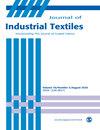Characterisation and photo-fatigue behaviour of UV-sensitive photochromic systems produced using electrospinning
IF 2
4区 工程技术
Q1 MATERIALS SCIENCE, TEXTILES
引用次数: 0
Abstract
This research aimed to create a UV sensor using photochromic pigment in nonwoven form and analyse its fatigue resistance under continuous ultraviolet (UV) light. The photochromic polymeric matrices consist of a photochromic pigment, a polymer, and a photo stabilizer, which enhance the stability of the photochromic systems under light exposure. As a base matrix, we used polyvinyl butyral. Then, we added different amounts of the photochromic pigment 5-chloro-1,3,3-trimethylspiro [indoline-2,3′-(3H) naphtho (2,1-b) (1,4)-oxazine]. We produce photochromic nonwovens by electrospinning a polymeric matrix solution with varying pigment concentrations. The study aimed to create a UV sensor with photochromic nanofibers that are very sensitive to light. It also tested how well it can degrade under continuous UV radiation by looking at its photo fatigue resistance under constant UV irradiation for its final use as a UV sensor material. Using FTIR, CRM, SEM, and XRD techniques, this study investigates the physiochemical properties and photodegradation behaviour of photochromic nonwovens and writes a report on it. The photo-light stability of photochromic materials is a major problem concerning its external stimuli in different substrate forms. It also looks at how well they resist photo-chemically towards the UV light. The fatigue resistance measurements were carried out using a FOTOCHROM3 spectrophotometer under continuous UV irradiance using two different modes. This study evaluated and reported their photodegradation behaviour in cyclic and continuous UV irradiance modes. The tests showed that the prepared photochromic system works well with photostability and can go through more than 20 exposure cycles, each with 100 min of UV light and intensity equal to 1/3 of the sun’s rays on a clear day. Given the PVB applications in our daily lives, it can serve as a UV sensor in numerous industrial applications. Photochromic nanofibers possessing excellent photosensitivity hold immense promise as optical rewritable devices and colourimetric-based UV sensors.利用电纺丝技术生产的紫外线敏感光致变色系统的特性和光疲劳行为
本研究旨在利用无纺布形式的光致变色颜料制作紫外线传感器,并分析其在连续紫外线(UV)照射下的抗疲劳性。光致变色聚合物基质由光致变色颜料、聚合物和光稳定剂组成,这些物质可增强光致变色系统在光照射下的稳定性。我们使用聚乙烯醇缩丁醛作为基质。然后,我们添加了不同量的光致变色颜料 5-氯-1,3,3-三甲基螺[吲哚啉-2,3′-(3H) 萘 (2,1-b) (1,4)- 恶嗪]。我们通过对含有不同浓度颜料的聚合物基质溶液进行电纺丝,生产出了光致变色无纺布。这项研究的目的是用对光非常敏感的光致变色纳米纤维制造紫外线传感器。该研究还通过观察纳米纤维在持续紫外线照射下的抗光疲劳性,测试了纳米纤维在持续紫外线照射下的降解性能,以便最终将其用作紫外线传感器材料。本研究使用傅立叶变换红外光谱、CRM、扫描电镜和 XRD 技术,研究了光致变色无纺布的理化性质和光降解行为,并撰写了相关报告。光致变色材料的光稳定性是涉及其在不同基底形式下的外部刺激的一个主要问题。报告还考察了这些材料对紫外线的光化学抗性。抗疲劳性测量是使用 FOTOCHROM3 分光光度计,在两种不同模式的连续紫外线照射下进行的。这项研究评估并报告了它们在循环和连续紫外线辐照模式下的光降解行为。测试结果表明,所制备的光致变色系统具有良好的光稳定性,可以经历 20 个以上的照射周期,每个周期的紫外线照射时间为 100 分钟,照射强度相当于晴天太阳光的 1/3。鉴于 PVB 在我们日常生活中的应用,它可以在许多工业应用中用作紫外线传感器。光致变色纳米纤维具有出色的光敏性,有望成为光学可重写设备和基于比色法的紫外线传感器。
本文章由计算机程序翻译,如有差异,请以英文原文为准。
求助全文
约1分钟内获得全文
求助全文
来源期刊

Journal of Industrial Textiles
MATERIALS SCIENCE, TEXTILES-
CiteScore
5.30
自引率
18.80%
发文量
165
审稿时长
2.3 months
期刊介绍:
The Journal of Industrial Textiles is the only peer reviewed journal devoted exclusively to technology, processing, methodology, modelling and applications in technical textiles, nonwovens, coated and laminated fabrics, textile composites and nanofibers.
 求助内容:
求助内容: 应助结果提醒方式:
应助结果提醒方式:


